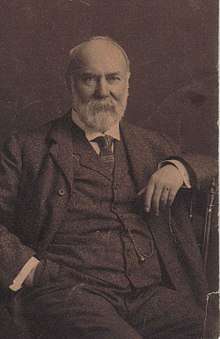John Waldie
John Waldie (April 22, 1833 – June 12, 1907) was a Canadian politician and businessman.
John Waldie | |
|---|---|
 Portrait of John Waldie (1906) | |
| Member of Parliament for Halton | |
| In office 1887–1888 | |
| Preceded by | William McCraney |
| Succeeded by | David Henderson |
| In office 1888–1891 | |
| Preceded by | David Henderson |
| Succeeded by | David Henderson |
| Personal details | |
| Born | April 22, 1833 Hawick, Roxburghshire, Scotland |
| Died | June 12, 1907 Toronto, Ontario, Canada |
| Resting place | Burlington, Ontario, Canada |
| Political party | Liberal |
| Profession | lumber merchant |
Biography
Born in Hawick, Roxburghshire, Scotland, he moved to Canada West when still a youth.[1] When the rest of his family moved to Huron County to establish a farm,[2] he decided to remain in Nelson Township, becoming a prominent wheat merchant.[3] He was Reeve of Nelson Township for two years,[1] and was instrumental in incorporating the Village of Wellington Square in 1873.[3] After Wellington Square was amalgamated with Port Nelson to become the Village of Burlington late that year,[3] he became its Reeve for five years.[1] During that time, he was also Warden of Halton County for two years.[1]
In 1885, he sold his interest in his business to his partner, and became a lumber baron, moving to Toronto in the process.[3] He founded the Victoria Harbour Lumber Company (consolidating three mills then operating)[4] that year,[2] located at Victoria Harbour, Ontario.[3] Many of the buildings he had constructed there have since been designated as heritage properties.[5] He would acquire further mills in his lifetime, including one in Spragge, Ontario just one month before his death.[1]
He was also the President of two tanneries, located at Collingwood and Burk's Falls,[1] and was a director on the boards of the Toronto Paper Company (operating in Cornwall) and the Canada Coating Mills (located in Georgetown).[1]
Waldie was also a director of the Bank of Toronto,[1] and had also been vice-president of the Landed Banking and Loan Company in Hamilton, Ontario,[1] which later became part of Canada Permanent Trust.
He was elected to the House of Commons of Canada as a Member of the Liberal Party in the 1887 election to represent the riding of Halton, later being re-elected in 1888, but defeated in the elections of 1891 and 1896. In that time, he developed a close friendship with Wilfrid Laurier, which proved useful after he left office.[2]
Electoral record
| 1896 Canadian federal election | ||||||||
|---|---|---|---|---|---|---|---|---|
| Party | Candidate | Votes | % | ±% | ||||
| Conservative | David Henderson | 2,460 | 50.9 | -0.2 | ||||
| Liberal | John Waldie | 2,376 | 49.1 | +0.2 | ||||
| Total valid votes | 4,836 | 100.0 | ||||||
| 1891 Canadian federal election | ||||||||
|---|---|---|---|---|---|---|---|---|
| Party | Candidate | Votes | % | ±% | ||||
| Conservative | David Henderson | 2,441 | 51.1 | +1.4 | ||||
| Liberal | John Waldie | 2,337 | 48.9 | -1.4 | ||||
| Total valid votes | 4,778 | 100.0 | ||||||
| Canadian federal by-election, August 22, 1888 | ||||||||
|---|---|---|---|---|---|---|---|---|
| Party | Candidate | Votes | % | ±% | ||||
| On Mr. Waldie being unseated, January 19, 1888, for bribery by agents, and the subsequent winner Mr. Henderson being then unseated for corrupt practices by agents | ||||||||
| Liberal | John Waldie | 2,042 | 50.3 | |||||
| Conservative | David Henderson | 2,018 | 49.7 | -1.4 | ||||
| Total valid votes | 4,060 | 100.0 | ||||||
| 1887 Canadian federal election | ||||||||
|---|---|---|---|---|---|---|---|---|
| Party | Candidate | Votes | % | ±% | ||||
| Liberal | John Waldie | 2,222 | 50.1 | -1.1 | ||||
| Conservative | David Henderson | 2,213 | 49.9 | |||||
| Total valid votes | 4,435 | 100.0 | ||||||
Further reading
- Armson, Kenneth A.; McLeod, Marjorie (2007). The Legacy of John Waldie: A History of the Victoria Harbour Lumber Company. Toronto: Dundurn. ISBN 978-1-55002-758-7.CS1 maint: ref=harv (link)
References
- "Death of John Waldie, Ex-M.P." The Acton Free Press. June 20, 1907. p. 2.
- Gillies, Mark (March 2, 2015). "John Waldie 'The Father of Burlington' paid for the library and created the Greenwood cemetery". Burlington Gazette.
- "John Waldie: An outstanding citizen of early Burlington". Burlington Post. January 8, 2010.
- "Victoria Harbor Lumber Company Mills". Tay Township Heritage. February 28, 2016.
- Gillies, Mark (March 13, 2015). "Gillies thinks civic recognition of John Waldie embarrassing and pathetic, suggest naming something significant after the 'Father of Burlington'". Burlington Gazette.